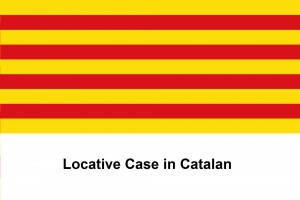Difference between revisions of "Language/Catalan/Grammar/Locative-Case-in-Catalan"
| Line 1: | Line 1: | ||
[[File:Locative Case in Catalan.png|alt=Locative Case in Catalan|thumb | [[File:Locative Case in Catalan.png|alt=Locative Case in Catalan|thumb]] | ||
In Catalan, the locative case is used to indicate the location or place where an action takes place. It is also used to indicate the time when an action takes place. In this lesson, we will learn about the locative case in Catalan and how it is used. | |||
== Formation of the Locative Case == | |||
The locative case is formed by adding the preposition "a" before the noun that represents the location or time. The preposition "a" is used before the noun to indicate that it is in the locative case. For example: | |||
* "Jo vaig a casa" means "I am going home." | |||
* "El tren arriba a les set" means "The train arrives at seven." | |||
== Usage of the Locative Case == | |||
The locative case is used in Catalan to indicate the location or place where an action takes place. For example: | |||
* "Jo visc a Barcelona" means "I live in Barcelona." | |||
* "El parc està a prop de la plaça" means "The park is near the square." | |||
The locative case is also used to indicate the time when an action takes place. For example: | |||
* "Jo treballo de dilluns a divendres" means "I work from Monday to Friday." | |||
* "La festa comença a les vuit del vespre" means "The party starts at eight in the evening." | |||
In some cases, the locative case is used in combination with other prepositions to indicate more specific locations or times. For example: | |||
* "Jo vaig a la platja amb els meus amics" means "I am going to the beach with my friends." | |||
* "La reunió és a la sala de conferències" means "The meeting is in the conference room." | |||
== Conclusion == | |||
The locative case is an important part of Catalan grammar, and it is used to indicate the location or time when an action takes place. By learning how to use the locative case correctly, you can improve your Catalan language skills and communicate more effectively with native speakers. | |||
Revision as of 19:45, 2 March 2023
In Catalan, the locative case is used to indicate the location or place where an action takes place. It is also used to indicate the time when an action takes place. In this lesson, we will learn about the locative case in Catalan and how it is used.
Formation of the Locative Case
The locative case is formed by adding the preposition "a" before the noun that represents the location or time. The preposition "a" is used before the noun to indicate that it is in the locative case. For example:
- "Jo vaig a casa" means "I am going home."
- "El tren arriba a les set" means "The train arrives at seven."
Usage of the Locative Case
The locative case is used in Catalan to indicate the location or place where an action takes place. For example:
- "Jo visc a Barcelona" means "I live in Barcelona."
- "El parc està a prop de la plaça" means "The park is near the square."
The locative case is also used to indicate the time when an action takes place. For example:
- "Jo treballo de dilluns a divendres" means "I work from Monday to Friday."
- "La festa comença a les vuit del vespre" means "The party starts at eight in the evening."
In some cases, the locative case is used in combination with other prepositions to indicate more specific locations or times. For example:
- "Jo vaig a la platja amb els meus amics" means "I am going to the beach with my friends."
- "La reunió és a la sala de conferències" means "The meeting is in the conference room."
Conclusion
The locative case is an important part of Catalan grammar, and it is used to indicate the location or time when an action takes place. By learning how to use the locative case correctly, you can improve your Catalan language skills and communicate more effectively with native speakers.
